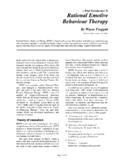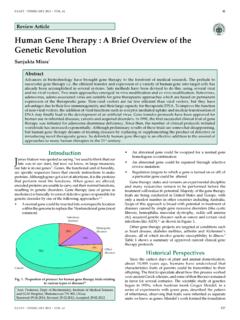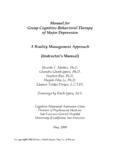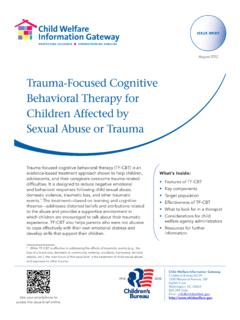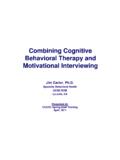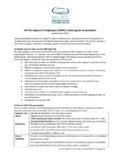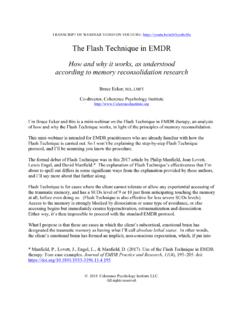Transcription of A Brief Introduction To Cognitive-Behaviour Therapy
1 A Brief Introduction ToCognitive-BehaviourTherapyBy Wayne FroggattThis version:Jul-2009 Cognitive-Behaviour Therapy (CBT) is based on the concept that emotions and behaviours result (primarily,though not exclusively) from cognitive processes; and that it is possible for human beings to modify suchprocesses to achieve different ways of feeling and behaving. There are a number of cognitive -behavioural therapies, which, although developed separately, have many historyThe cognitive psychotherapies canbe said tohave begun with Alfred Adler, one of Freud s innercircle.
2 Adlerdisagreed with Freud s idea that thecause of human emotionality was unconsciousconflicts , arguingthat thinkingwas amoresig-nificant Behaviour Therapy has its modernoriginsin the mid 1950 s with the work ofAlbertEllis, a clinical psychologist. Ellis originallytrained in psychoanalysis, but became disillusionedwith the slow progressof his clients. He observedthat they tended to get better when they changedtheir ways of thinking about themselves, theirproblems, and the world.
3 Ellis reasoned that ther-apy would progress faster if the focus was directlyon the client s beliefs, and developed a method nowknown asRational Emotive Behaviour Therapy (REBT).Ellis method and a few others, for ex-ample Glasser s Reality Therapy and Berne s Transactional Analysis ,were initiallycategorisedunder the heading of CognitivePsychotherapies .The second major cognitive psychotherapy wasdeveloped inthe 1960 sbypsychiatrist AaronBeck;who,like Ellis,was previously a psychoana-lyst.
4 Beck called his approachCognitive Therapy (CT).(Note thatbecause the term CognitiveTherapy is alsoused to refer tothecategoryofcognitive therapies,which includes REBT andotherapproaches,it issometimes necessarytocheckwhetherthe useris alluding tothegeneralcategoryortoBeck s specific variation).Since the pioneering work of Ellis andBeck, anumber of othercognitiveapproaches have devel-oped, manyas offshoots of REBT or term cognitive Behaviour Therapy came into usagearound the early 1990 s, initiallyusedbybehav-iouriststo describebehaviour Therapy with a cog-nitive flavour.
5 In more recent years, CBT hasevolved into a generic term toinclude the wholerange of cognitively-oriented and CT have been joined by such develop-ments as Rational Behaviour Therapy (MaxieMaultsby), Multimodal Therapy (Arnold Lazarus),Dialectical Behaviour Therapy (Marsha Linehan),Schema Therapy (Jeffrey Young) andexpanded bythe work of such theorists as Ray DiGiuseppe, Mi-chael Mahoney, Donald Meichenbaum, Paul Salk-ovskis and many of these approaches are characterised bytheir view that cognition is a key determining fac-tor in how human beings feel and behave.
6 And thatmodifying cognition through the use of cognitiveand behavioural techniques can lead to productivechange in dysfunctional emotions and nowitwillbeseenthat CBT is a genericterm that encompasses not one but a number ofapproaches. When readingarticles or texts onCBT,it is helpful toidentify the theoretical per-spectiveinvolved. Often they are saying the samething, butusing different aware ofthe terminological differences willhelp the readerunderstandand, hopefully,integratethe article will present an approachthatcombinesREBT and CT.
7 Incorporating ele-ments of some other approaches as of causationCBT is not just a set of techniques it also con-tains comprehensive theories of human proposes a biopsychosocial explanationas to how human beings come to feel and act asthey do that a combination of biological, psy-chological, and social factors are most basic premise is that almost all hu-man emotions and behaviours are the result ofwhat people think, assume or believe (about them-selves, other people, and the world in general).
8 It isPage2of12what people believe about situations they face not the situations themselves that determines howthey feel and REBT & CT, however, argue that a per-son s biology also affects their feelings and behav-iours an important point, as itis a reminder tothe therapist that there are some limitations on howfar a person can useful way to illustrate the role of cognitionis with the ABC model. (originally developed byAlbert Ellis, the ABC model has been adapted formore generalCBT use). In this framework A represents an event or experience, B representsthe beliefs about the A, and C represents theemotions and behaviours that follow from is an example of an emotional episode , asexperienced by a person prone to depression whotends to misinterpret the actions of other event:Friend passed me in the street without acknowl-edging A:He s ignoring me.
9 He doesn t like m unacceptable as a friend so I must beworthless as a me to be happy and feel worthwhile, peoplemust like :Emotions:hurt, :avoiding people that A doesn t cause C : A triggers off B ; B then causes C . Also, ABC episodes donot stand alone: they run in chains, with a C of-ten becoming the A of another episode we ob-serve our own emotions and behaviours , and reactto them. For instance, the person in the exampleabove could observe their avoidance of other peo-ple( A ), interpret this as weak( B ), and engagein self-downing( C ).
10 Note, too, that most beliefs are outside con-scious awareness. They are habitual or automatic,often consisting of underlying rules about howthe world and life should be. With practice,though, people can learn to uncover such subcon-scious is dysfunctional think-ing?We have seen that what people think determineshow they feel. But whattypesof thinking are prob-lematical for human beings?A definitionTo describea belief as irrational is to say blocks a person from achieving their goals,creates extreme emotions that persist and whichdistress and immobilise, and leads to behav-iours that harm oneself, others, and one s life reality(it is a misinterpretation ofwhat is happening and is not supported by theavailable evidence).
